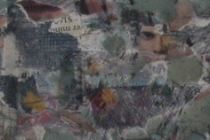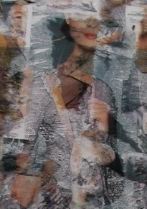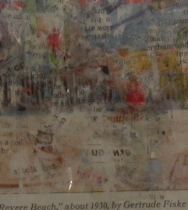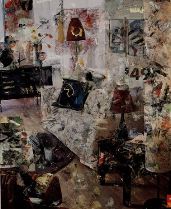 Judy Engle emailed me at the Weekly to invite me to see a small exhibit of her collages in the teacher’s lounge at Community College. She reminded me that I hadn’t made it to a previous exhibit of hers, and that triggered the Catholic guilt in me and off I went. While the exhibit space, in the teachers’ lounge, was nothing special (in fact it is a utilitarian space with copy machine, lunch/meeting table and bulletin boards and would be a killer for some work), it was fine for Engle’s intimate pieces. The collages were seductive and intriguing and because you went in close to see them, they overcame the space.
Judy Engle emailed me at the Weekly to invite me to see a small exhibit of her collages in the teacher’s lounge at Community College. She reminded me that I hadn’t made it to a previous exhibit of hers, and that triggered the Catholic guilt in me and off I went. While the exhibit space, in the teachers’ lounge, was nothing special (in fact it is a utilitarian space with copy machine, lunch/meeting table and bulletin boards and would be a killer for some work), it was fine for Engle’s intimate pieces. The collages were seductive and intriguing and because you went in close to see them, they overcame the space.engle, judy
The work is serious, ambitious and technically unique — narrow strips of taped pieces of imagery that build up to mostly abstract fields with an underwater drowsiness to them. The artist’s statement, which was sassy and smart, seemed part art history lesson and part confessional. Quoting from the statement:
“In an illustrious group that includes Romare Bearden, Robert Motherwell, and Joan Miro, Hannah Hoch is my favorite collage artist….As a so-called “outsider artist,” I am expected to be obsessive in my work and I am happy to oblige.”
The entire package intrigued and I wanted to know more.

Over coffee, I learned that Engle, a bouncy, talkative 61, is an English teacher, something she’s done for 39 years. Evenings and weekends she stays up late making art. She does a lot of gallery-going, here and in New York, and is informed and passionate about what she sees. She buys art, even when it stretches her pocketbook. She longs to have the balance of her life change so that she could spend more time making art and less time at her day job which pays the bills.
Engle’s need to make art runs deep. While not schooled in art, the artist’s background of growing up on a farm in Bucks County surrounded by mother, father and grandfather who did everything themselves (from building the house they lived in to designing and stitching the clothes they wore to growing their food) propelled her into the world of hands-on object-making.
“I did a sweater for a doll when I was eight years old. I can do a whole lot of things. I got that from a farmer and a carpenter and a housewife who wanted to be a fashion designer,” she said.
“Everybody made things. They were creating things. Necessity is the mother of art,” she said.

Talking about her work habits, Engle said “I work every day….sometimes I don’t have the time to do the dishes and the laundry.” She reads the NY Times every day and the newspaper is source material for the collages. One time she used the Ikea catalog but that was the exception. A number of years ago, Engle applied for a Leeway grant in photography. She wanted to study with a mentor, Ellen Priest, who teaches collage art at UArts. She didn’t get the grant but she went ahead with the mentoring sessions, at her own expense, which tells you a lot about the artist’s zeal and determination.

Lately, Engle has been applying to juried exhibitions — and getting in. In fact, she’s been in three exhibits so far this year. “I get in to a lot of shows that people who’ve been to art school don’t get in to,” she said, amazed and bemused. Early on, her art was photography but now she’s dedicated to collage. She loves the process and has found success showing and selling it. She’s been in shows at Perkins Center for the Arts and the Sedgewick Cultural Arts Center.
As a collage artist, Engle is intimately acquainted with tape. In particular she loves packing tape. Several of the works I saw, which were long and narrow, were from what she calls the “1.88 Project.” The standard width of all packing tapes is 1.88 inches and the pieces in the “1.88 Project” were ribbons of collage exactly 1.88 inches wide.

So Engle is having a little fun with her art, as well as obsessing over it. The artist has numerous friends and supporters and she’s got several irons in the fire, like sending slides to a publisher so her work can be considered for book covers. What I loved most about the work — and the artist — is the clear confidence that the work has value and that it communicates a “topsy-turvy” world that’s quite a bit like the one we live in, breathless with imagery, fragmented and in collision with itself. Without being spiritual in nature, Engle’s collages are wonderful meditations on life in 2005. (all images are details from collages by Engle; last image is based on the Ikea catalog.)









